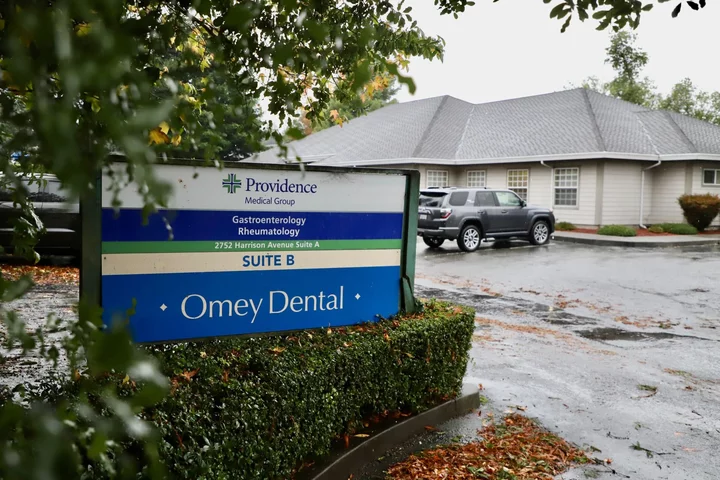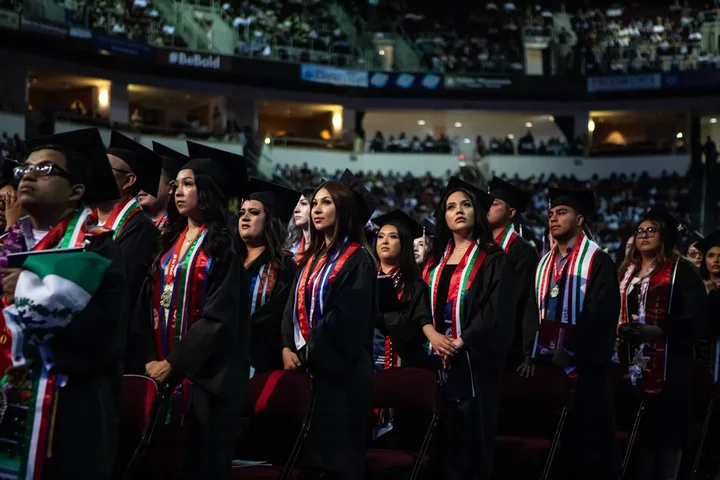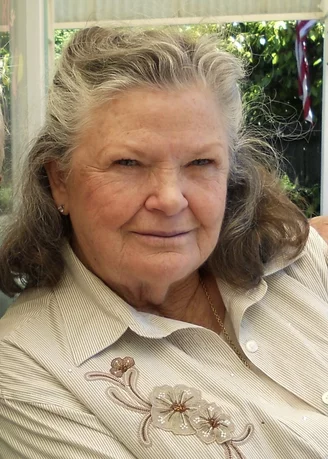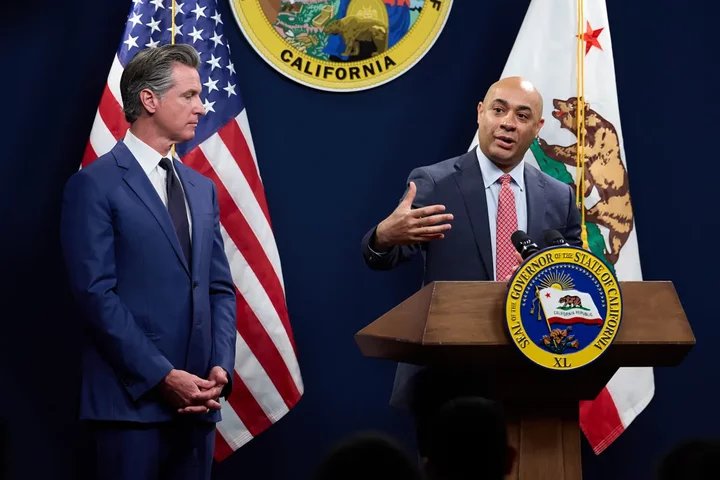Providence Not Accepting Referrals for Routine Procedures From Providers at Practices They Don’t Own
Ryan Burns / Friday, Nov. 22, 2024 @ 7:45 a.m. / Health Care
Providence Medical Group’s gastroenterology and rheumatology offices on Harrison Avenue in Eureka. | Photo by Andrew Goff.
###
Providence Medical Group Eureka, which employs Humboldt County’s only specialists offering such vital services as cardiology, gastroenterology and more, has stopped accepting patient referrals for many routine procedures from offices they don’t own and operate, forcing many local patients to travel to Santa Rosa, Napa or beyond.
Angela Smith, founder and managing director of the independently owned Kidney Care Services of Humboldt, learned about this new policy indirectly back in September after she made three separate referrals to Providence’s gastroenterologist specialty group, only to have them declined. She was told that the office was only accepting referrals from within Providence Medical Group.
In a phone interview, Smith said she called the office to voice her concerns: namely, that this policy will exclude a significant number of local patients from receiving necessary services such as colonoscopies. Many of her patients require a colonoscopy before they get placed on the list to receive a kidney transplant.
“The office manager explained that the decision had come from administration,” Smith told the Outpost. “They had been advised to recommend referring patients to Santa Rosa or asking a medical provider employed by Providence if they would create the referral themselves.”
Smith found these suggested work-arounds ridiculous.
“No provider is going to regularly absorb this extra work,” she said, “and many of these affected patients do not have the means to travel to Santa Rosa for services.”
Ia Thao is one such patient. When we spoke with her in September, she was undergoing dialysis three days per week. Her referral to Providence’s local gastroenterology office was declined, and she was instead referred to the Providence-owned office in Santa Rosa. Squeezing such a trip between her dialysis appointments on Tuesdays, Thursdays and Saturdays would be a challenge.
“If I drive down there and come back the same day it’s going to be hard for me,” she said. “The traffic down there, too, it’s kind of hard for me.” Plus, the procedure typically requires sedation, which prevents the patient from legally driving for hours afterward.
Another of Smith’s patients, a man who asked not to be identified while discussing medical issues, said he, too, was denied a local colonoscopy appointment. He needs the procedure before he can get a kidney transplant. The longer he has to wait, he said, “it’s that much longer that I’m on dialysis, and it’s that much longer before I get a kidney transplant. So, yeah, it’s quality of life issue.”
Fortunately for him, he has the resources to fly to the Mayo Clinic in Phoenix.
“We’re fortunate that we can,” he said. “I feel bad for the people that can’t … . All of a sudden it turns our society into an elitist [one] because only the people with the right insurance and enough financial wherewithal are allowed to get the treatment they need.”
Local family medicine practitioner Dr. Stephanie Dittmer has also been frustrated by this new policy and its impacts on her patients.
“I’m getting my referrals rejected, and the reason that’s being communicated to my office staff and my patients is that they are no longer accepting referrals from non-Providence physicians,” Dittmer said in a recent phone interview. “It directly impacts patients, so it becomes a discriminatory thing in the sense of who can financially afford to stop work and go out of the area for something and come back.”
In response to a list of questions, Providence, the not-for-profit Catholic health care system that took over St. Joseph Health in 2016, emailed a media statement saying that the new policy was forced upon them due to “a critical shortage of physicians and advanced practice clinicians” nationwide.
“The inability to accept every referral, especially those which are not urgent or time sensitive, is an unfortunate reality of healthcare today, especially in rural communities like Humboldt County,” the statement says.
But Smith said the urgency of any given patient’s situation should be determined by their doctor.
“General surgery [at Providence] has said it will be eight months out before they can get a colonoscopy because it’s not considered an urgent procedure, necessarily,” she said. “But in terms of my patients, that’s a big deal because that’s eight months of potentially missing a kidney.”
Providence’s new policy appears to have been made at the corporate administrative level, which Smith considers inappropriate.
“The way that they made the decision… is not in line with how medical offices review medical referrals,” she said, adding that such decisions should be made by medical professionals. Smith is well aware of the shortage of specialists here but said a blanket refusal to accept out-of-network referrals from practices they don’t own is not the ethical approach.
“We’re not saying that they don’t have a provider shortage; we’re saying that the way they’ve decided which patients they’re not going to see is not in line with how medical offices do this,” she said. “It sounds like an administrative decision that was taken out of the hands of a medical provider, where it’s supposed to be. .. This decision should not have come from administration. … Nobody else does that.”
Providence’s media statement goes on to say that its medical group is willing to coordinate directly with referring providers to ensure that urgent or special needs are met and the patient’s health remains a top priority.
“We also work closely with our Santa Rosa and Napa medical group providers to provide telehealth visits as an additional option to improve access to care whenever possible,” the statement reads.
Dittmer said such telehealth visits are very rarely possible, and she noted that cardiology is another specialty that has been affected by physician shortages.
“I’ve had to send people literally out of the area to Santa Rosa to get their cardiac angiograms done because the wait time to get into cardiology is excessive, even when people have abnormal studies,” she said.
Rosemary Den Ouden, CEO of the Humboldt Independent Practice Association, said the agency is in the process of credentialing a “desperately needed” cardiologist, but the shortage of medical specialists is simply a harsh reality.
“It’s hard to get some of the most basic things right now because we just don’t have the bodies here in Humboldt County,” Den Ouden said. For example, the county has a severe shortage of gastroenterologists. “We know that for some of our members, the wait time could be up to a year, especially if it’s for routine screening.”
Dittmer said this situation is not new.
“I’ve had to refer people out of town on the regular for the last, like, literally two years, because Providence hasn’t been able to meet the volume needs of the people here locally,” she said.
Den Ouden said the shortage is not for lack of recruitment efforts. She said Providence is doing a great job of recruiting, and every single practice in the county is continually working on both recruitment and retention of physicians. In its media statement, Providence Medical Group said that since its inception it has brought “well over 100 primary, specialty, and hospital-based providers to the community.”
However, it doesn’t say how many of those have since left the area.
This afternoon, shortly before this post was published, Providence Medical Group sent an updated statement that included one new paragraph:
There has been a significant financial investment and time/energy spent to improve the overall access to gastroenterology care in Humboldt County. To tackle the backlog of endoscopy procedures and increase access to crucial, lifesaving GI screenings, Providence has contracted with three additional gastroenterologists and secured the commitment of five other physicians who are qualified to perform GI procedures. These concerted efforts are aimed at reducing wait times and ensuring more patients receive timely and essential gastrointestinal screenings, ultimately improving patient outcomes and overall community health.
Den Ouden said that, to a certain extent, local residents may simply have to accept that we won’t have local access to all of the care we may need.
”This might come off a little curt, but a place like Humboldt County, we’re never going to have a left eyeball specialist,” she said. “We work hard just to have a cardiologist, an orthopedic surgeon, some GI and primary care, but there will never be a time when we have all these super-specialized positions. There will always be reasons people have to travel outside the area. I don’t think that will ever change.”
Smith didn’t argue with that notion, but she reiterated that Providence shouldn’t make executive decisions affecting broad swaths of the public without consulting with local providers and working with them to develop plans for how best to serve the community.
“It’s as if we’ve all just resigned ourselves to this powerless situation that we have,” she said. “The primary concern I have is that it doesn’t need to be that way. It shouldn’t be that way. And the clout and the size that Providence has in our community, although we’re all deeply appreciative of it, they’re not willing to sit down and have any kind of discussion at the table.”
###
CORRECTION: The headline of this post has been corrected from its original version to reflect that Providence is refusing referrals from practices it does not own, rather than from patients who are out of network.
BOOKED
Today: 2 felonies, 5 misdemeanors, 0 infractions
JUDGED
Humboldt County Superior Court Calendar: Today
CHP REPORTS
No current incidents
ELSEWHERE
RHBB: Efforts to Locate 15-Year-Old Liliana Foley Continue in Crescent City
Governor’s Office: While Trump turns his back on LA fire survivors, Governor Newsom issues order creating more flexibility for recovery and rebuilding
KINS’s Talk Shop: Talkshop November 24th, 2025 – Rob Arkley
RHBB: Paving Work Scheduled Nov. 24–26 Between E Street and Spruce Street
California State University Increases Its Graduation Rates but Is Falling Short of Its Ambitious Goals
Mikhail Zinshteyn / Friday, Nov. 22, 2024 @ 7:42 a.m. / Sacramento
Graduating students take their seats at the Fresno State Chicano/Latino Commencement Celebration in the Save Mart Center in Fresno on May 18, 2024. Photo by Larry Valenzuela, CalMatters/CatchLight Local
California State University is only partially meeting its bold plan to graduate 40% of its students who started as freshmen by the end of four years. In newly released data this week, the system saw its four-year graduation rate inch to an all-time high of 36.2% this year — more than double the graduation rate it posted in 2013.
The system has one year left to make good on its Graduation Initiative 2025 goals, which it debuted in 2015. The splashy effort was buttressed by a combination of system and state funding increases that over time reached $400 million annually. That money has gone toward hiring more professors, opening more classes in courses with high waitlists that students need to graduate, cutting the number of students finishing classes with Ds and Fs and reaching out to students who dropped out.
The growth in graduation rates overlapped with a 31% spike in freshmen enrollment between 2009 and 2019, meaning the system’s graduation rate increased even as it was absorbing an additional 15,000 students.
The type of students Cal State enrolled changed as well, explained Jennifer Baszile, an associate vice chancellor for the system, at the board of trustees meeting Wednesday. In that same period, the university saw a 50% jump in freshmen who were the first in their families to attend college, come from low-income households or identify as Black, Latino or Native American — all groups that campuses have historically struggled to graduate at rates similar to other students.
“We are opening up opportunities for students who traditionally have not had them,” said Diego Arambula, vice chair of the board of trustees, at Wednesday’s meeting.
Among transfer students, the system is even closer to its 2025 goals, having graduated 44% of students within two years who came from community colleges — just shy of the 45% target it set for itself. Graduation rates are calculated separately for students who start as freshmen and those who transfer. Lately, about 40% of Cal State’s new students are transferring from other schools.
Gaps remain between racial and ethnic groups
But for the system’s other core goals to eliminate the differences in graduation rates between Black, Latino, Native American and all other students, the gaps remain recalcitrant.
The six-year graduation rate for Latino students, the system’s largest racial or demographic group, dipped from a high of 58% in 2021 to 56% in 2024 — well short of the 2025 goal to have 70% of all students who started as freshmen graduate within six years but higher than the 52% in 2015.
White and Asian students as distinct groups reached or surpassed the 70% goal by 2020.While the traditional timeline for earning a bachelor’s degree is four years, the six-year graduation rate is a common metric that reflects the modern realities for many students: They work to afford their education and care for families, activities that require them to enroll in a reduced number of courses, which means they take longer to graduate.
For Black students, the graduation rate remains stubbornly low — at no point has Cal State graduated more than 50% of Black students at the end of six years who started as freshmen. At spring’s end this year, the rate stood at 49 percent — a full 21 percentage points below the 70% goal.
Cal State is the nation’s largest public four-year university system and is home to more than 400,000 undergraduates.Another immovable gap is the one between students receiving federal Pell grants because they come from low-income families and those who don’t.
At Cal State, nearly half of students receive this benefit and they graduate at rates 10 to 12 percentage points below those of students from families with higher incomes. The gulf between students with and without Pell grants is supposed to close completely by next year under the goals Cal State set forth.
“Closing equity gaps is really, really hard,” said Christopher J. Steinhauser, a trustee who was superintendent of the Long Beach public k-12 school system, among the state’s largest. “Sometimes when you have initiatives and people do better, the gaps actually grow, and we actually have seen that here in our own system.”
Covid’s impact
One force constraining graduation rates is the effect the COVID-19 pandemic had on students remaining in school. A key early measure of whether students will graduate is how many return after their first and second years of school. At Cal State, that so-called retention figure gradually grew until the pandemic struck. Among students who started as freshmen in 2019, about 85% returned after their first year. But for those who started in 2020, the year Covid devastated the world’s public health systems and plunged many families into financial distress, the share of returning students dropped to 83% and the next year to 81%.
Once students leave, it’s difficult to persuade them to return, higher-education experts say.
Still, Cal State has a higher overall graduation rate than most other similar universities in other states. The University of California, which rejects far more applicants than Cal State, graduates about 72% of its freshmen within four years — double that of Cal State.
###
CalMatters.org is a nonprofit, nonpartisan media venture explaining California policies and politics.
OBITUARY: Johnnie Elaine Hillegeist, 1935-2024
LoCO Staff / Friday, Nov. 22, 2024 @ 6:56 a.m. / Obits
Johnnie
Elaine Hillegeist passed peacefully at home on November 17, 2024. She
was born on September 9, 1935, in St. Augustine, Texas. When she was
eight years old, she left The South and moved to Bakersfield, but
would never leave her Southern accent behind. At 13
years old, she met and married Pedro Hillegeist, whom she would be
happily married to for 65 years, until his death in 2014.
In 1956, Mom and Dad, with their two young sons, settled in Humboldt County. They raised us here while enjoying Humboldt County’s many treasures: collecting agates, digging for old bottles and whatever else they may find. They also enjoyed antiquing, fishing, hunting and much later in life, they found pleasure in the local casinos.
She is survived by her son David (Jennifer), her grandchildren Erin Mentesh (Michael), Kelly Dodd (Greg) and William Hillegeist (Jodi), as well as nine great grandchildren and many nieces and nephews. She shared much love over the years with her niece, Angelique. A very heart felt thank you to Pedro Vega for being her partner and a special part of our family for the past six years. We are so grateful for you, Pedro!
She was preceded in death by her husband Pedro Hillegeist, her son Michael and his son Michael Brian Hillegeist, her sister Demerace Crutchfield, her brother Jim Quinn, as well as many others who were near and dear to her heart.
Funeral services will be held at Ocean View Cemetery on Tuesday, November 26, at 11 a.m.
###
The obituary above was submitted on behalf of Johnnie Hillegeist’s loved ones. The Lost Coast Outpost runs obituaries of Humboldt County residents at no charge. See guidelines here. Email news@lostcoastoutpost.com.
Juvenile Suspect Arrested After YET ANOTHER School Shooting Threat Found Written in Eureka High Bathroom
LoCO Staff / Thursday, Nov. 21, 2024 @ 3:18 p.m. / Crime
Eureka High School | Outpost file photo: Andrew Goff.
###
Press release from the Eureka Police Department:
On Monday, November 19, 2024 at approximately 9:49 a.m., school administrators were made aware of a school shooting threat written in a restroom of the main building. Upon notification, Eureka Police Department Officers, including the School Resource Officer, immediately responded, took actions to ensure the safety of students and staff, and began investigating. At approximately 11:52a.m., a second threat was found in the same building.
After an extensive investigation, the School Resource Officer and Criminal Investigations Unit Detectives identified a suspect. On Thursday, November 21, at approximately 10 a.m. the juvenile suspect was arrested, charged with PC 422 Criminal Threats, and booked into Juvenile Hall.
This incident was determined not to be associated with similar threats reported at schools in the past few weeks.
According to Commander La France, “We will continue using all internal and external resources to identify any individuals involved in this type of criminal behavior as threatening the safety of children in the community is completely unacceptable. Individuals involved in these types of school threats should expect to be identified, arrested, and booked into juvenile hall or jail.”
###
PREVIOUSLY:
- Yet Another Shooting Threat Found at Eureka High Before Homecoming; Student Arrested, No Connection to Previous Incidents, EPD Says
- Eureka High on Lockdown For the Third Time This Month, Following Another Threat
- Eureka Police Department Seems to Say That Yesterday’s EHS Lockdown Involved Two Separate Threats, One After The Other, Or Something Like That
- Eureka School Briefly Went on Lockdown in Response to Threats Tuesday Evening
HealthSPORT By The Bay Is Not Closing — Not at All! — But It’s Not Going to Be There Anymore Come January
Isabella Vanderheiden / Thursday, Nov. 21, 2024 @ 1:15 p.m. / News
HealthSPORT By The Bay. | Photo: Andrew Goff
###
Earlier this week, the Outpost heard a little rumor that local fitness chain HealthSPORT has plans to close its By The Bay location in Old Town Eureka. We quickly launched an investigation into the matter and discovered that HealthSPORT is not closing By The Bay, per se, it’s just moving all operations and equipment at that gym over to its Eureka location on Pennsylvania Avenue in Myrtletown.
Reached by phone this morning, HealthSPORT Marketing Director Courtney Haraldson took great pains to avoid saying By The Bay is “closing,” insisting instead that HealthSPORT is simply “relocating” and “consolidating” Eureka’s gym offerings.
“The building will no longer be something that we’re renting, but the word ‘closing’ isn’t really true because By The Bay is just moving to [the Myrtle Avenue location in] Eureka,” Haraldson said. “It’s no longer a space that we need. It doesn’t serve us for the programs that we need to offer.”
Asked if HealthSPORT’s decision to consolidate gym services was in response to dwindling attendance at its Old Town location, Haraldson said “that’s not really what we’re looking at,” adding that By The Bay was “designed for small group classes.”
“A lot of the people that come to work out at By The Bay do so because they work down [in Old Town] or it’s closer for them, but all of our members that we’ve really talked to are excited about moving it to one spot,” Haraldson said.
Over the coming months, HealthSPORT plans to expand services and classes at its Myrtletown location and include more family-oriented activities.
“We want to focus more on families and our families [live] out that way,” Haraldson said. “We’re currently renovating our pool [at the] Myrtle [location], but our family swims are really popular there and we’re hoping to expand on that. We’re also looking forward to more youth birthday parties and field trips. … It’s more of a communal vibe. We also have a very large parking lot there and plan to host food trucks or other little community events. We want to create a space for people to spend more time together.”
HealthSPORT will close relocate By The Bay at the end of December, though some pilates classes may continue at the Old Town location through January while the new space is getting set up. HealthSPORT’s program schedule can be found here.
###
California’s Budget Is ‘Roughly Balanced,’ but Growing Deficits Expected
Alexei Koseff / Thursday, Nov. 21, 2024 @ 7 a.m. / Sacramento
Gov. Gavin Newsom, left, listens as Joe Stephenshaw, director of the Department of Finance, speak during a press conference unveiling Newsom’s revised 2024-25 budget proposal at the Capitol Annex Swing Space in Sacramento on May 10, 2024. Photo by Fred Graves for CalMatters.
With tax revenues from high-earning Californians rebounding in recent months, the Legislature’s nonpartisan fiscal analyst projects that the state budget remains “roughly balanced,” though spending growth is expected to drive increasing deficits in the years ahead.
In its annual fiscal outlook, issued Wednesday to prepare lawmakers for the upcoming budget process, the Legislative Analyst’s Office estimates that California will face a $2 billion deficit next year, a potential gap that could be resolved with minor solutions.
“Given the size and unpredictability of the state budget, we view this to mean the budget is roughly balanced,” the office concluded.
Tax collections are forecast to beat expectations by $7 billion for the year, largely driven by stock market gains.
But that money is projected to be offset by spending more than $10 billion higher than the current state budget assumed, including more guaranteed funding for schools and community colleges from the additional revenue. Other large unexpected costs include for fighting wildfires and an expanding caseload for state health programs for seniors, as well as a November ballot measure approved by voters that raises reimbursement rates for doctors who treat poor residents.
Gov. Gavin Newsom and the Legislature passed a $298 billion budget this summer that aimed to address a major deficit, estimated to be tens of billions of dollars over the next two years.
The Legislative Analyst’s Office warned yesterday that the state is still on that path in the longer term, with a projected annual deficit of about $30 billion by the 2028-29 fiscal year, and urged lawmakers not to commit to any new ongoing spending.
“This recovery in income tax revenues is being driven by the recent stock market rally, which calls into question its sustainability in the absence of improvements to the state’s broader economy,” the office wrote, noting that hiring and consumer spending are still sluggish.
Assembly Speaker Robert Rivas agreed with that assessment in a statement emphasizing a cautious approach.
“We need to show restraint with this year’s budget, because California must be prepared for any challenges, including ones from Washington,” Rivas said in a statement. “It’s not a moment for expanding programs, but for protecting and preserving services that truly benefit all Californians.”
The annual fiscal outlook by the Legislative Analyst’s Office is merely a forecast and can vary greatly from the projection by the Department of Finance that the governor uses for his budget proposal in January.
Last December, the Legislative Analyst’s Office estimated a $68 billion deficit for the next fiscal year — frustrating Newsom, whose spending plan unveiled in January relied on a smaller $38 billion expected revenue gap. He repeatedly criticized the media for its widespread reporting on the Legislative Analyst’s Office figure.
Seemingly recalling those criticisms, Legislative Analyst Gabriel Petek published an essay last week defending his office and “the value of independence” as it helps the Legislature understand the choices it may face.
“Our independent fiscal assessment underlies the Legislature’s ability to assert an informed check on the executive branch, making any added complexity from diverging estimates a worthwhile trade-off,” Petek wrote.
###
CalMatters.org is a nonprofit, nonpartisan media venture explaining California policies and politics.
Conservative Professors and Students Are Suing California’s Community Colleges, and Winning
Adam Echelman / Thursday, Nov. 21, 2024 @ 7 a.m. / Sacramento
Juliette Colunga in the library at Master’s University in Santa Clarita, on Oct. 5, 2024. Photo by Carlin Stiehl for CalMatters
At California’s community colleges, conservative professors and students are making their voices heard — not just in the classroom but in court. Their lawsuits have already led community colleges to pay millions in settlements and legal fees.
CalMatters identified at least seven cases filed since 2020 in which professors or students have sued their community college districts for issues related to free speech. Most of the cases are still ongoing and are located in California’s Central Valley, in counties where Republicans often outnumber Democrats. Although separate, many of these lawsuits include similar allegations: that programs promoting diversity, equity and inclusion are restricting the right to free speech under the First Amendment. The University of California system is facing a similar case in Santa Cruz.
In a state with 73 community college districts and 116 community colleges, such lawsuits are rare. Still, president-elect Donald Trump has used similar cases as fodder for national policy, such as a 2019 executive order he signed regarding free speech on college campuses, which he justified by pointing to a few conservative and religious students who claimed colleges had restricted their rights. Throughout his campaign for this year’s election, Trump promised to continue that focus if re-elected.
“The time has come to reclaim our once great educational institutions from the radical left,” he said in a campaign video last year, later adding that he would protect free speech and remove “all Marxist diversity, equity, and inclusion bureaucrats” from college campuses.
Even when these lawsuits get dismissed, community colleges can still pay a price. In a Riverside County lawsuit, Moreno Valley College professor Eric Thompson claimed the community college violated his right to free speech when it fired him. The lawsuit alleges that his termination was a result of various student complaints, all stemming from opinions that Thompson had presented in class or over email with the wider college community. He argued, for example, that homosexuality is the result of social factors, not genetics, and that conversion therapy should be allowed. Thompson lost the case but public records show that the district still paid nearly $900,000 in legal costs to fight it.
“It was never about making money. It was not only about making change, but also about ensuring that change remains for future students.”
— Juliette Colunga, former student at Clovis Community College
For Daniel Ortner, an attorney who recently helped students and professors file three different lawsuits against community college districts, these cases are part of a broader trend of cracking down on controversial speech and forcing “conformity to a certain viewpoint,” especially on topics of race. Ortner works for the Foundation for Individual Rights and Expression, a nonprofit organization that focuses on free speech issues.
The community college system, the California State University system, and the UC Office of the President all have policies promoting diversity, equity and inclusion on their campuses, though each system has taken a different approach.
Ortner said the policies at the community college level are the strictest, and therefore, elicit more pushback from faculty. According to state regulations adopted in 2022, every community college district in the state must develop a policy to evaluate staff based on their ability to advance diversity, equity, inclusion and accessibility.
“Students must experience campus and classroom cultures that they feel they can belong to, where they can thrive and succeed” said Eloy Ortiz Oakley, then-chancellor of the community college system, during a 2022 presentation about the new regulations. Of the more than 2 million students who enrolled at one of the state’s community colleges last year, most are low-income, including some students who are former foster youth or formerly incarcerated. Most students identify as Black, Hispanic, or Asian.
The California community college system has the “most diverse student population in the nation,” said Ortiz Oakley, later adding that neither the CSU nor the UC system had similar regulations in place. “We should be proud that we’re leading the way.”
Nationally, many college systems have taken the opposite approach. A total of 25 states have proposed or signed legislation curbing how colleges support diversity, according to the Chronicle of Higher Education.
Lawsuits over pronouns, posters, and alleged censorship
Many of the California lawsuits follow the same general contours.
According to the details of one case, David Richardson, a professor at Madera Community College, started using the pronouns “Do, Re, Mi” while attending a 2021 presentation about personal gender pronouns. When the facilitator later approached Richardson about his choice of pronouns — calling his actions “harmful to trans people” — Richardson doubled down, claiming that his choice of pronouns was part of his right to free expression. After the college disciplined him, Richardson sued the State Center Community College District, which oversees Madera Community College. The case is still pending in federal court.

The Campus Center of Bakersfield College on June 14, 2023. Photo by Larry Valenzuela, CalMatters/CatchLight Local
Another lawsuit at Bakersfield College dates back to 2019, when two professors, Matthew Garrett and Erin Miller, put together a campus talk about “free speech” and “campus censorship.” During the talk, Garrett and Miller criticized the school for supporting Kern Sol News, a nonprofit news site, and criticized specific professors at the school’s Social Justice Institute. Bakersfield College administrators then wrote a note in their personnel files, criticizing Garrett and Miller for “unprofessional conduct,” effectively “chilling” their First Amendment rights, according to the lawsuit.
The Kern Community College District settled with Garrett this summer, paying him $2.4 million on the condition that he drop all of his legal complaints against the district. It’s less than 1% of the district’s annual budget, but for a faculty member, many of whom make around $100,000 a year, it’s a significant sum. Miller is continuing with the case.
In the settlement, both Garrett and the district deny any wrongdoing. “The settlement is in the best interest of the District and allows us to focus on the future and continue to deliver quality higher education for students of Kern County without any further legal distractions,” said Norma Rojas, a spokesperson for the Kern Community College District, in a written statement. “To be clear, the dispute with Matthew Garrett was a disciplinary matter due to his disruptive actions on campus, none of which concerned freedom of speech.”
Miller and Garrett declined multiple requests to comment.
Another Central Valley case stems from an incident in 2021. At the time, Juliette Colunga was a student at Clovis Community College and on the leadership team of her college’s chapter of the Young America’s Foundation, a national conservative organization with local branches at over 2,000 college campuses. She and two other students placed a set of posters across campus that criticized communism, which the college then removed after other students complained. Later, Colunga and her co-leaders asked to put up pro-life posters, but school leaders said they could only be placed in a different location, far from the spot where they usually placed their content. With help from Ortner and the Young America’s Foundation, she and the other student leaders sued, alleging that the school district’s actions violated their First Amendment Rights.
This summer, the State Center Community College District, which oversees Clovis Community College, agreed to pay her, the other student leaders, her attorneys, and the Young America’s Foundation $330,000 as part of a legal settlement. The district also agreed to implement a new policy for displaying posters on campus and to provide “First Amendment training” to all of its managers.
“It was never about making money,” Colunga said. “It was not only about making change, but also about ensuring that change remains for future students.”
Kristen Kuenzli Corey, general counsel to the State Center Community College District, declined to comment on Colunga’s lawsuit, Richardson’s lawsuit, and another similar lawsuit. She pointed to the pleadings in the cases as evidence of the district’s position.
Do public employees, students have the right to free speech?
In general, the free speech provision of the First Amendment governs the relationship between people and government. Faculty and students at a public college have a right to free speech under the First Amendment, but in a slightly more limited manner, said David Snyder, the executive director of the First Amendment Coalition. Various courts have found that public institutions can limit the free speech rights of its employees — in this case, faculty — if an employee’s behavior runs counter to the mission of the institution. Schools also have a right to restrict their students’ speech, but only if it disrupts education. The most famous example is the “Tinker test,” where the U.S. Supreme Court said that students had a First Amendment right to free speech, as long as their conduct did not “materially and substantially interfere” with education.

Students walking at the Madera Community College campus on Aug. 28, 2023. Photo by Larry Valenzuela, CalMatters/CatchLight Local
“What also matters is what the school’s policies say,” Snyder said. Regardless of the constitutional questions, a professor or student can sue if they feel the school’s actions contradict its policies.
In addition to its policy on diversity, equity and inclusion, California’s community college system also has a policy on academic freedom, which states that faculty, staff, and students should have “the opportunity to express their opinions at the campus level.”
The regulations around diversity, equity and inclusion do not conflict with the academic freedom policy or otherwise “censor or compel speech,” said Paul Feist, a spokesperson for the community college system, and he pointed to a lawsuit filed by Bakersfield College professor Daymon Johnson as evidence. Johnson does not agree with the college’s principles of diversity, equity and inclusion and claims that being forced to adhere to them would infringe on his rights, according to the case. A judge recently dismissed Johnson’s claims, though he has appealed the ruling. Neither the district nor Johnson responded to requests for comment.
Of the seven lawsuits identified by CalMatters, most have taken years to resolve.
Colunga’s lawsuit settled this summer — almost three years after she and the other student leaders first put up the posters at Clovis Community College. By the time the case settled, she had already graduated and transferred to The Master’s University, a private, four-year Christian college near Los Angeles.
She said the school doesn’t have an official chapter of Young America’s Foundation, but she’s trying to get one started.
###
Adam Echelman covers California’s community colleges in partnership with Open Campus, a nonprofit newsroom focused on higher education.
CalMatters.org is a nonprofit, nonpartisan media venture explaining California policies and politics.







